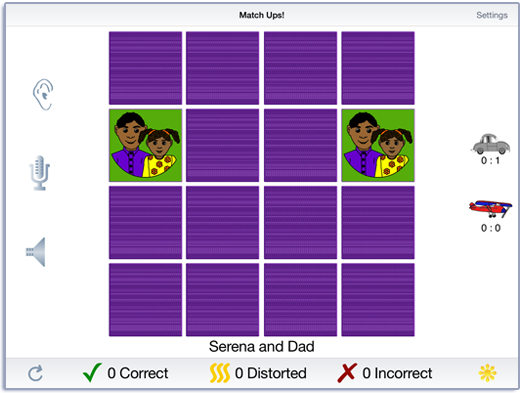
Match Ups! is one of our favorite games of all time. The first version of Match Ups! was added to our Attention and Memory:Volume I CD in 1996 and we’ve been enhancing it ever since. We reused many of your favorite card sets and made lots of new cards for this version. Old favorites include Contrasts, Verbs, and African animals as well as animal drawings and people from the Artic Practice app. You can also choose alphabet letters, numbers, geometric shapes, and emoji. For a real challenge, pick the cards that use the shapes from our And, Or, But… Following Simple Directions app.
The game starts out with you against the computer. At first the computer plays randomly, but you can make the game more challenging by increasing the computer’s skill level to Beginner, Good, or Expert. When playing in the expert level, the computer rarely makes a mistake—it is very hard to beat. You can also play with a friend. Just type their name in the second box and away you go. If you want to play by yourself, you can do that too.
All devices can display 4, 6, 16, 24, or 36 cards on the screen. Retina iPads, iPhone 6, and iPhone 6 Plus are large enough and clear enough to also display 48 and 64 cards on the screen. You can choose simple blue, green, purple, or red card backs or spice things up and choose fun backs.
You can pick from an English or Spanish language voice in the options. If the voice is in Spanish, the text will be as well.
Target Audience Match Ups! is primarily a fun memory game, but we added sounds and text so you can use it as a learning exercise as well. Special education teachers can use it to develop a fund of knowledge and to practice turn taking. SLPs can use it as an aphasia exercise, for speech articulation practice, or as a visual scanning task. SLPs tell us that they often use it as a reward at the end of a therapy session.
Just $1.99 on the App Store.
Rationale This task is intended for clients in Rancho Levels VII and above. This is a task of psychomotor performance relatively unaffected by intellectual ability, long-term memory functioning, or previous learning. It requires motor persistence; sustained visual attention and scanning; visuomotor coordination; and the ability to encode and recall the symbols. (Lezak 1985) It is designed to utilize Luria's (1973) third functional unit; planning and verification of activity.
This game is appropriate for individuals with auditory/visual short-term memory deficits, as well as verbal rehearsal and confrontation naming problems. This game is also appropriate for children and adults learning English as a second language.
The format is intentionally low key and simple in order to provide an uncomplicated background for learning these concepts. The multisensory approach requires the child to listen to stimuli, repeat information aloud, and touch the screen to make choices.